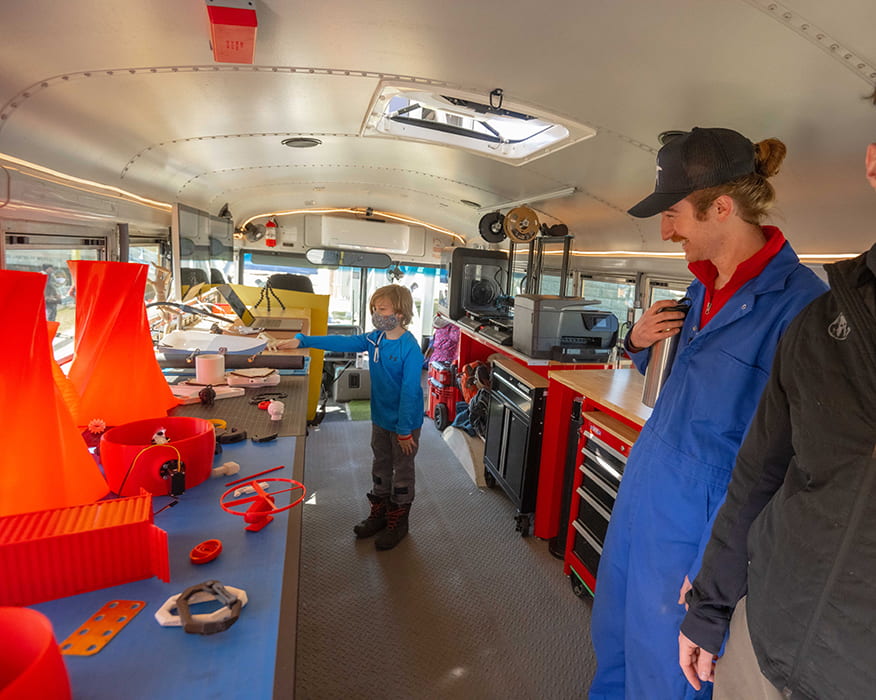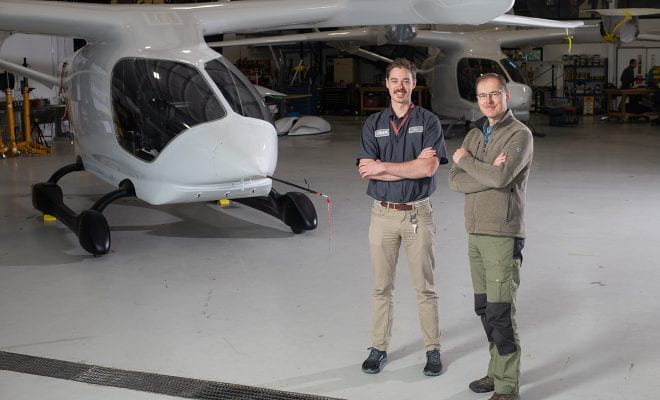Fly the Greener Skies
Herman Wiegman '88 and Nathan Wiegman '15 are helping chart the course of electrical flight.
Read StoryJeremy Trilling ’22 has the kind of imagination that’s exciting and a little mind-boggling—one that envisions a future where the jet stream moves packages, and people, around the world.
“Having this third dimension of traveling will enable a lot more use of space and evoke more awe in everything,” he says. “People will be awestruck by the world we live in.”
Keeping up with Trilling’s lightning-fast thought process can shift most people into perpetual catch-up mode as they try to grasp the nebulous ideas he sees as nearly concrete. And while that might be an intimidating trait in some, Trilling’s affable, kind, and exceptionally easy-going manner pulls others into the realm of possibilities. He wants you to see what he envisions because that’s half the fun of it.
The amount of creative confidence and skills I’ve acquired has been noticeable, for sure. I have learned other skills to help me create the things I want to see in the world.
In the years since Trilling’s unconventional arrival at WPI in a flying electric vehicle he built and nicknamed “the pumpkin carriage,” he has been a tireless maker, using all the tools at his disposal—some of his own creation—to expand the realm of air travel.
Trilling found unexpected academic and professional opportunities despite the pandemic’s arrival in the middle of his WPI years. With remote courses and two summers and a semester-long co-op at aerospace manufacturer BETA Technologies in Burlington, Vt., he did a lot of hybrid learning. “It was an amazing learning opportunity I didn’t expect,” he says.
He worked with BETA’s fleet of helicopters and fixed-wing airplanes to help advance the company’s mission to manufacture electric vertical take-off and landing (eVTOL) aircraft, says Trilling, which gave him purposeful hands-on experience.
“I’m taking a standard two-person helicopter and converting it to electric propulsion,” he says. “It’s lots of deep learning.” He has also helped BETA create a six-person capacity eVTOL with fixed wings and rotors. Not content to understand only the ground operations, Trilling recently earned his full private helicopter pilot’s license.
He also dove into WPI’s innovation and entrepreneurship (I&E) ecosystem, tapping into WinterSession, Value Creation Initiative, Tinkerbox programs, and the I-Corps program. “It’s a blessing to be part of a student community to help me through design projects,” he says, noting that the programs also offered connections with I&E leaders, business leaders, and alumni who have guided his path and who share his enthusiasm.
Trilling’s robotics engineering major augments all the technical details. “The curriculum has done a nice job of overlapping the kinds of things I wanted to learn,” says the California native. “The amount of creative confidence and skills I’ve acquired has been noticeable, for sure. I have learned other skills to help me create the things I want to see in the world.”
When Trilling talks about flying vehicles, he doesn’t just mean airplanes, or even typical things you’d see when you look up. His focus is now on lighter-than-air aircraft and how to access and use the airspace at about 30,000 to 50,000 feet. At that point, the jet stream takes over and can move things quickly around the world in the west-to-east 100 mph currents, he says.
Getting to those heights begins a little closer to the ground. His recent work focuses on developing an electric propulsion system to allow the pilot of a hot air balloon to retain full lateral control of the balloon’s position while still maintaining altitude control with the propane burner, he says. He’s also working on developing a 50-foot vertical airship-lifting envelope that can be attached to heavier objects to supplement lift with less motor use.
Linking his fascination with air travel to watching the magical animation movies of Hayao Miyazaki in Studio Ghibli, Trilling’s imagination embraces cargo, airships, and even tiny flying homes moving in that space. “If you float up there you can go around the world in about 10 days with no real energy usage,” he says. “I can foresee this being a very low-cost and green way to transport very large goods domestically and internationally.”
On campus, Trilling is easily spotted getting around on any one of his electric vehicles (he’s also retrofitted a 40-foot-long, solar- and electric-powered bus—basically a machine shop on wheels). It’s a great way to meet people in what he calls WPI’s “delightful community” and to find personal satisfaction. “It just adds to a general enhancement of your day,” he says.
He’s so committed to WPI’s maker community that his IQP team’s project focused on developing a comprehensive list of where to go and who to talk to for all the campus maker spaces. For his MQP, Trilling will work on a precision aerial drop device for safely detonating and disposing of hazardous land mines. The project is appealing for its immediate use, but he’s even more interested in the potential. “I can see this for package delivery,” he says, “and getting things from the air to the ground.”

Jeremy Trilling shows off his machine shop on wheels at 2022 Touch Tomorrow
And as a prolific creator, Trilling says his inevitable failures offered lessons along the way. A particularly nasty hot air propulsion system test that went wrong resulted in a shattered propeller that landed frighteningly close to Trilling’s eye. “That taught me to take it slower, to be more cognizant, and to not rely on others for your own safety,” he says. “It calmed the pace a little.”
Trilling arrived on campus hoping to find others as motivated as he was to explore what’s possible. He wasn’t disappointed. “A few days ago I went through some awesome design work with friends and professors,” he says. “The hype of foreseeing a future that’s creatable is the awesome part of this community—and having the freedom to create and the tools to do so.”

Herman Wiegman '88 and Nathan Wiegman '15 are helping chart the course of electrical flight.
Read Story